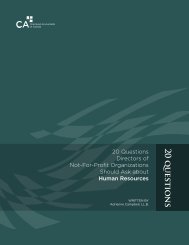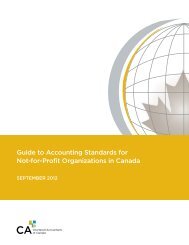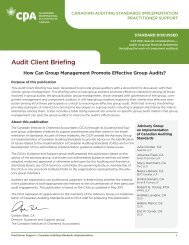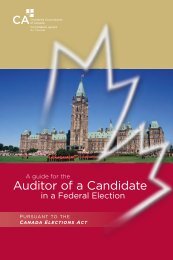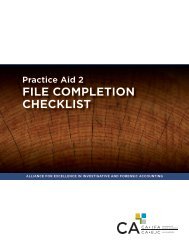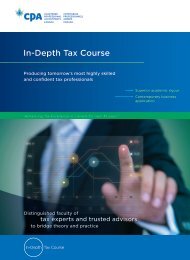20 Questions - Canadian Institute of Chartered Accountants
20 Questions - Canadian Institute of Chartered Accountants
20 Questions - Canadian Institute of Chartered Accountants
You also want an ePaper? Increase the reach of your titles
YUMPU automatically turns print PDFs into web optimized ePapers that Google loves.
Strategic Planning y continued zOpportunities and Threats are external factors that can help or hinder theorganization: the economy, demographics, government policy, stakeholderneeds and preferences, etc. Opportunities include the unmet stakeholder needsand expectations that the organization could potentially serve. Threats includethe potential for increased costs and reduced financial support.Identifying external opportunities and threats requires a thorough understanding<strong>of</strong> the environment in which the organization operates, and the capacity torecognize events trends and other factors that could affect it. Board memberswho have knowledge and experience <strong>of</strong> issues that are relevant to the organizationcan be particularly valuable contributors to brainstorming sessions.Not-for-pr<strong>of</strong>it organizations typically have limited or no control over externalfactors. They may be able to influence government policy but, in most cases,they need to revise their strategies to meet changing circumstances. Boards havethe potential to play a significant role in supporting and/or promoting newstrategies or by participating in initiatives to influence government policy.The results <strong>of</strong> SWOT analysis can be used to:• Adjust or eliminate existing programs and projects• Add new programs or projects• Establish plans to resolve internal weaknessesRecommended practices• The organization considers its internal strengths and weaknesses indeveloping its strategic plan• The organization considers its external opportunities and threats indeveloping its strategic planSee CICA’s <strong>20</strong> <strong>Questions</strong> Directors Should Ask about Risk7. What risks does the organization face?SWOT analysis is closely related to risk management – the process that identifiesand addresses the risks that affect day-to-day operations and sustainability. Riskmanagement essentially asks:• What could happen that would affect our ability to meet our objectives?• How likely is it to occur?• How serious might it be?• What should we do to reduce the risk?• How can we be prepared to respond to problems?Boards <strong>of</strong> directors are responsible for monitoring the organization’s processesfor managing risk which should include:• Promoting an awareness <strong>of</strong> the need to manage risk• Identifying and assessing the risks that could affect the achievement <strong>of</strong> theirstrategy• Developing and implementing methods and procedures for managing risk• Learning from their experiences with risk.Managing risk is an ongoing responsibility <strong>of</strong> management who must followboard-approved policy and keep the board informed. The board can ensure thatit includes risk on its agenda by including a discussion <strong>of</strong> risk and opportunityin strategic planning sessions and by requiring the Executive Director to raisecurrent risk issues at board meetings. Organizations with an Audit Committeecan instruct the committee to review financial and other risk issues and reporton them to the board.Recommended practices• The organization has identified the major risks that could affect itsoperations and provides reports on them to the board• Management and the board consider risks when developing the strategicand operating plans• The organization has policies and procedures for managing risk• The board makes time in its agenda to discuss risk• The organization takes risks seriously and manages them well10










